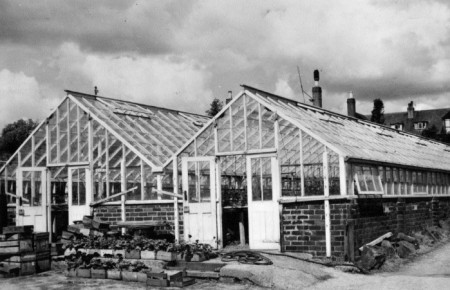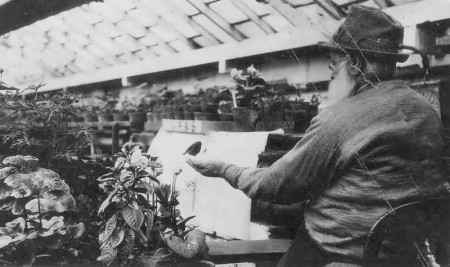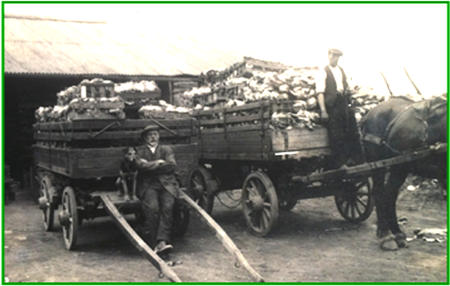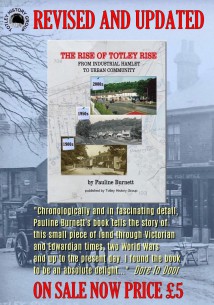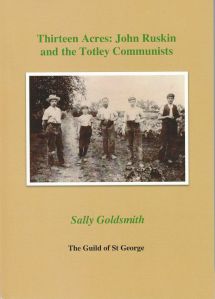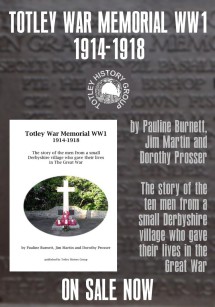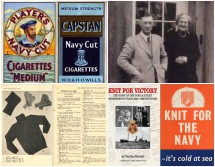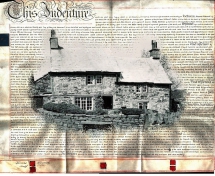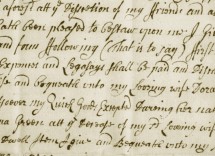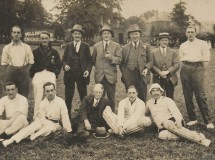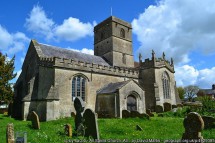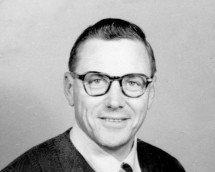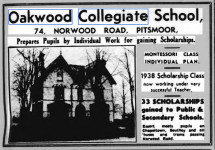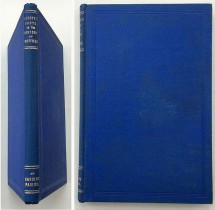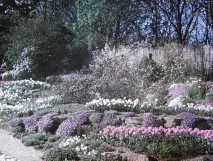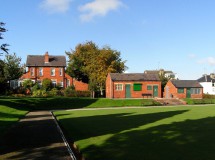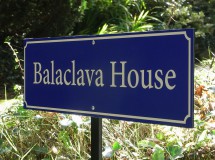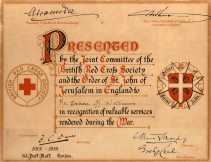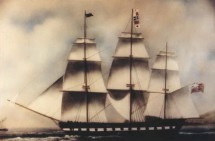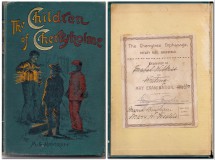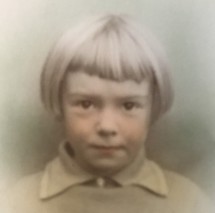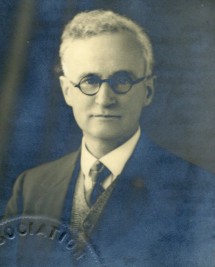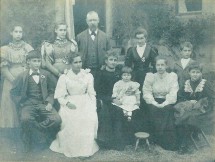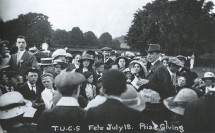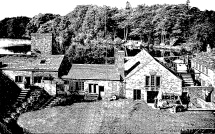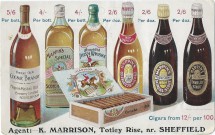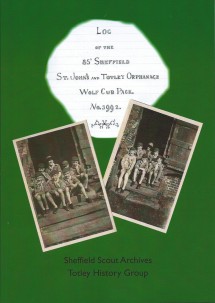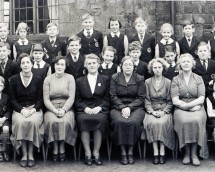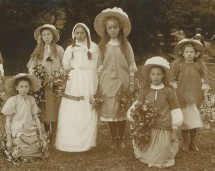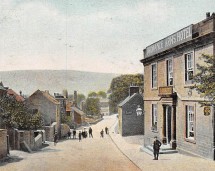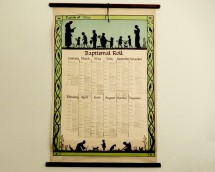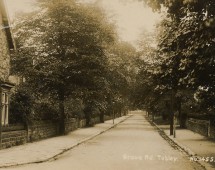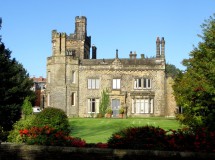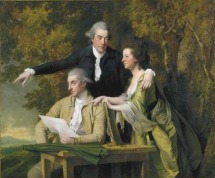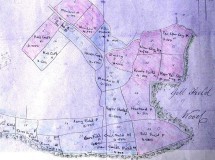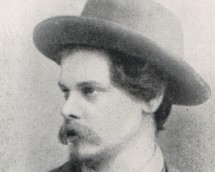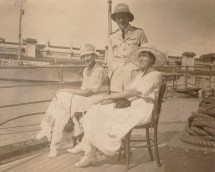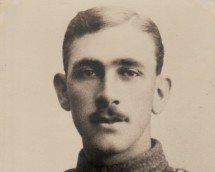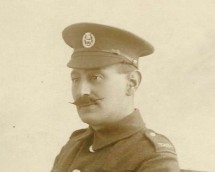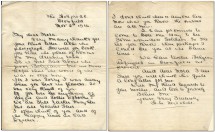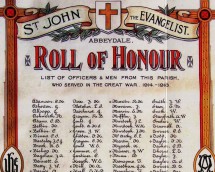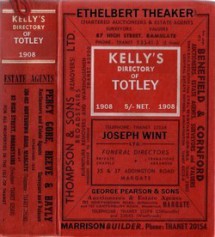The Pearson Family
by Tom Pearson, March 1978
I well remember the 23rd May 1914. Although not yet 14 years of age I had been left school, Dronfield- Woodhouse, some two months, and on the morning of the 23rd two events made me remember the day and the date.
A very severe frost had ruined my father's fruit crop, but the other event was my grandfather's death in my home at St George's Farm in the early hours aged 81 years. My grandfather, Samuel Pearson, spent most of the summer months with us after he turned over Bluster Farm Cutthorpe, to his youngest son Robert.
It was my first introduction to a dead person. Samuel Pearson's (1833-1914) parents died while he was quite a young man as they both died in the early or middle 1850 and that was why I never heard my father refer to his grandparents. My father George Pearson being Samuel's eldest son, this fact did not interest or strike me as unusual until many years after my father's death in December 1943 (1857-1943).
About the middle of the last - the 19th century my grandfather's landlord of Bluster Farm offered to build a new house and outbuildings if grandfather would cart the stone from Freebirch quarry and the lime from Stoneymiddleton along with the sand to make the mortar. There was a tollbar where several roads meet at the top of Grange Hill only a short distance from the entrance to the farm and having to pass through this gate every time cost him £5 at two pence each time extending over about two years.
Bluster Farm was really a very poor smallholding at an elevation of 800-900 ft above sea level so that to support a family grandfather had to find other work. He was a great man with a scythe and at hay and com harvest was a welcomed extra hand on the larger farms in the neighbourhood. He would cut the grass along the lanesides and make it into hay. He was in demand as the local pig killer and would walk up to two miles after the day's work to kill and dress a pig for nine pence and got the following evening to cut up the carcass ready for salting etc. for sixpence. In wintertime he would get a labourers job in the quarry. Grandfather had a cousin who was a partner in a pottery manufacturing business in Chesterfield and who emigrated to New Zealand in the early 1860s. When this gentleman came to say "Goodbye" to his cousin Samuel he took with him two earthware money boxes "for your two little lads Saml. George and Thomas. These names were impressed or moulded on the moneyboxes with a date of birth.
My father George Pearson was the eldest of a large family and never had a continuous schooling. He could only go to school on odd days whenever there happened to be a one penny piece to spare for that was admission fee.
When grandfather had work in the quarry during the winter there were a few more pennies to spare for school attendance for George and Sam.
There was an ironstone pit near Barlow and when my father was nine and a half years old he started work there.
The ore was drawn to the surface by a horse going round and round until the bucket reached the surface and my father had to see that the horse kept going until the bucket of ore reached the proper level for unloading and then turn the horse round ready for reversing the process. His pay was sixpence a day.
About this time my grandfather would sometimes take a cartload of hay to Sheffield to sell in the market there and my father having left the ironstone job would have a wonderful day out to go along with him.
At that time the railway approaching the tunnel to Dronfield was being made and there were no houses along the main road at Totley Rise, but there was a dam which provided waterpower for a cold rolling steel mill. Hence the present day name of a road there. Of interest to my father as a small boy were the ducks swimming about on the water. At this time Sheffield had reached out to Highfields in this direction.
When my father was about eleven and a half he went to work at a coalpit about four miles from home and had to be there by half-past six and go underground to use a hand pump to keep the water clear from where some miners were working.
It was eventually realised that this was beyond his capacity and at the age of around thirteen-fourteen he was hired out to a fanner for his keep. He said that the twelve months living-in on this farm was one. of the happiest of his life. There was unlimited milk and buttered oat cakes which were baked on an oven shelf which was a flat piece of iron over a bright smokeless fire. I have seen my mother using this method. While bread was a special treat reserved for Sundays and High Days.
In his late teens my father returned to the coal mine and was given the job as labourer to two miners who took advantage. of his ignorance as to what he should actually do. The result being that he became very weak and ill and lost his voice for some weeks.
He continued as a miner along with his next younger brother Thomas (1859-1923) until at the age of twentyfour-twentyfive he joined with another man by the name of John Furniss to rent a quarry at Rivelin on the north-west outskirts of Sheffield.
John had an aunt and uncle who had a farm in the neighbouring Loxley Valley and as a relaxation in summer and autumn my father and John would go to the farm Broadhead Flats - and help with the hay making, harvest and milking.
The farmer - by the name of Helliwell - had with other children, a daughter named Elizabeth, and on one occasion my father came upon her just in the act of commencing to milk about a dozen cows by herself. Of course he picked up a bucket and stool and joined in. Elizabeth eventually became my mother. Elizabeth's mother was a Miss Furniss and the Furniss line were descended from the Bagshawes of Haglibadge Hall (1575) Bradwell, Derbyshire.
At the time of writing (1978) the Hall is still standing with the date on the square stone set in the gable.
John Furniss and my father worked the Glen House quarry for some years producing dressed stone for house building which was in great demand at that time.
Some of the stone was taken by traction engine and trailer wagons, usually two trucks with eight tons in each to houses which were being build in Steade Road - off Abbeydale Road - and to a site at Meersbrook, and thereto hangs a story.
The engineers delivering the stone to Meersbrook had been unable to dump the sixteen tons of stone near enough to the actual site to satisfy the builder who would not pay for it until it was moved up to his satisfaction.
After a full day in the quarry and a meal John and my father walked across to the building site at Steade Road where they picked up barrows and planks and so across to Meersbrook.
The distance walked would be between four and five miles. After some hours of moving stone to the required place they began to feel somewhat hungry, so John went off in search of food. He was unlucky. All the shops were closed and he would not have entertained giving a thought to the possibility of finding something at a Public House.
Staunch teetotal both of them.
So they worked through the night, took the barrows and planks back to where they took loan of them and home to breakfast and began a new day in the quarry. My father said it was the hardest days work he ever did. John was a "character". He was tall and well built, light sandy hair and beard and long of leg. He liked to hear himself holding forth on the virtues of that new political thinking, Socialism.
My father and John would sometimes go into Sheffield on Saturday evenings and walking, would beat the horse trams from Hillsborough Comer to West Bar. There they would be joined by half a dozen or so of similar political views. By some loud mouthed threats and a bit of shadow boxing they staged what looked like a possible real Saturday night brawl.
This soon brought some onlookers. A good fight was worth seeing. John would then get up on his box and say - "Well seeing that you all want to hear I'll speak up a bit louder!", and would give his dissertation on the advantages of a socialist state.
The group styled themselves "The Working Men's Radical Association."
As members of the group took a wife and family responsibilities and work places changed, the group fell apart, but not before it had attracted the notice of one Edward Carpenter and other intellectuals who were social reformers of their day. St George's Farm had been one of John Ruskin's experiments and was at this time in the custody of a few people known as the Guild of St George who owned several properties.
Edward Carpenter knew that a new tenant was required for St George's Farm and approached my father on the matter.
The quarry work was given up and my father and mother moved to St George's Farm in February 1887 while John Furniss succeeded in getting the tenancy of a farm Moorbay Farm near Old Brampton.
This was the chain of events leading to my birth at St. George's Farm on the tenth of July 1900.
My mother said that the first friend she had on coming to live at Totley Rise was Doctor Thome as she had been at St George's Farm only a month when my eldest brother was born on the 24th March 1887.
Doctor Thome remained the family doctor until he died thirty years later. When the Doctor began his practice he travelled around on horseback and was in lodgings near Dore and Totley Railway Station.
Then came the horse and trap to be followed in the first decade of the 20th century by the first motorcar in the district, a Derbyshire Registration R.25.
In due course my father and mother had six sons and one daughter survive - one baby girl dying of influenza at the age of nine months.
John Ruskin's tenant of St George's was paid a retainers allowance to enable him to survive until he could bring the smallholding of about ten acres into production to be largely self-supporting.
It would appear that this occupier of St George's Farm was satisfied with his subsistence allowance and neglected the land work, because when my father took over, the place was in such a run-down state that the Guild of St George said he could have it rent free for a couple of years and then fix the figure at what he felt able to pay.
There being nothing on the place which was either eatable or saleable, he started hawking fruit and vegetables with sometimes a bit of fish thrown in which he bought in Sheffield market and sold on his way back to Totley.
Sheffield at that time reached about to Machon Bank, and where the Broadfield Road Swimming Baths stand was known as the Primrose Meadows, When the swimming bath first opened it was known by this name.
After returning home from his hawking my father would work on the holding until dark. Mother had a goat to supply them with milk.
The going was very hard for some years but gradually and slowly things began to improve and the family increased.
A cow took the place of the goat and the land began to be productive and by the end of three years the family had increased by three boys:-Charles 1887; Samuel 1888; Arthur 1890.
By the end of the century Charles and Samuel had left school and were working and three more children had been added to the family:- Lucy 1891; Frank 1893; Fred 1898.
A colliery had been started at Mickley and by carting coal from the pit to houses in the district the two older boys were able to contribute to the family income; an unenviable job for young boys in cold wet weather.
When in his middle teens Samuel took coal from Mickley to Whitlow Park House. The Dore and Chinley tunnel was being driven under the moors during the 1890 and there was an encampment of huts near the number four ventilating shaft down in the valley at Totley - locally known as Totley Bents - where the men working on the new Sheffield - Manchester line lived.
My father found a ready and profitable market for his hawking wares and his own produced vegetables with these people and particularly so when there was an outbreak of smallpox and this community was inclined to be shunned by the local trades people.
Although not vaccinated against the scourge he escaped infection.
By the year 1900 - the year of my birth - more live stock bad been acquired and this was having a twofold effect. The family was self supporting in milk, butter, bacon, eggs and poultry and the resultant manure from the stock restored fertility to the land which of course became more productive.
Charles - the eldest son - never got on well with his father who liked to feel that he was the boss, whether it be boss over dogs. horses or growing boys or girls, even his wife it would seem reasonable to assume.
Competition in the coal carting business became acute and a wait of two hours or more to get a cart load of coal was too much for Charles, so with the friction between himself and father steadily getting worse he decided to emigrate to New Zealand when he was approaching twenty-one years of age (Tilbury November 1907 SS Perilous)
John Furniss, previously mentioned, had gone to New Zealand with his second wife - the first having died and had been interred on the Moorhay Farm - and their eight children in 1902.
The Furniss homestead which was established on virgin land and was being brought into cultivation as a dairy enterprise provided a base for Charles to begin his life in the new country.
After a turn on a remote sheep station where he had a saddle horse and three sheep dogs and where he once did not see his mate or any other human being for ten days. he eventually settled on some very fertile land at Hexton near Gisbome where he established an orchard and produced in the fullness of time the best of several varieties of dessert apples that ever found their way to market.
He visited his old home on three occasions, 1912; 1937; and 1949 when he had to sell his home and orchard through being severely incapacitated with arthritic hips. In 1951 he helped to make surgical history in New Zealand by having new hip joints inserted in both within twenty-eight days.
Charles married Violet Edith Daisy Short in 1915 who returned to New Zealand with him after his visit home in 1912. He was the recipient of the first airmail letter to Gisbome which was sent by me as soon as the service was announced.
His wife Violet ran the Hexton Post Office at the time and received this information from Head Office. The time taken for the letter was three weeks, half the time for the usual surface mail
Charles died at Gisborne in 1956 and his wife at the same place in 1965. Charles and Violet had no children.
My father had built a small glass house and had made a start in the nursery trade which was developing steadily and his second son, Samuel was devoting most of his time along these lines and besides catering for the retail trade in the developing residential district was taking a good selection of herbaceous and indoor pot plants to Sheffield market on Tuesdays and Saturdays.
Some of the fruit trees, apple and pear, planted by John Ruskin were now in full bearing, while others propagated by my father were just coming into bearing in 1910.
The next two sons were coming towards manhood - Arthur being twenty and Frank seventeen - and it must have been obvious that they were too thick on the ground for harmonious working.
A disbanded and overgrown small fruit tree and shrub nursery in the middle of Birchen Lea Farm became available so my father rented it after it was cleared by Arthur and Samuel. The sycamore tree in Dronfield- Woodhouse at the junction of the main road with Oxclose Lane planted at the Coronation of King George V (the fifth) was one from this nursery. I was present a the ceremony; 22 June 1911.
Arthur put all his energies into this new bit of very good land and soon had quite a lot of plants for the Sheffield market.
The tenant of Birchen Lea Farm had decided to move so the tenancy was offered to my father, who consulted Samuel and Arthur as to whether he should accept. Neither of them wanted to go in for farming, so Frank, although not yet eighteen, said he would have a go and try his hand at farming.
So came the Pearson family to be the eventual owners of Birchen Lea Farm and three other small fields adjoining.
On the fourth of August 1914 Britain declared a state of war with Germany and in the same month Samuel married Florence May Short (born 16.2.1884) sister to Charles' wife - and left home to take a job as farm-hand with a cottage that went with the job on a farm at Loxley.
On the Birchen Lea Farm was a cottage which had remained unoccupied since the previous tenant had left, so Samuel returned in the following spring. and with his wife made the cottage more or less habitable.
It would probably be true to say that neither Samuel nor Arthur were called up for military service because Frank said he "would have a go and try his hand at farming".
It was now decided that the sons should become partners in the business as they became of age. Thus George Pearson and Sons Nurserymen and Market Gardeners.
A farm-hand had been engaged as a casual in 1911, and as he showed his adaptability and skill in any job that came his way, particularly in his handling of horses, he remained with Pearsons until he retired some twenty-five years later.
Samuel continued to manage Birchen Lea until the war was over. When in 1919 he left the firm of George Pearsons to go in to partnership with his cousin Charles Helliwell of High Matlock Farm, Stannington.
On the first of March 1918, Samuel and Mary's only child, Esther May was born. When Esther was five years old her mother died in June 1923 aged 39 years.
The younger sister of Florence May and Esther's aunt, Lily Victoria became housekeeper to Samuel and foster mother to little Esther.
The partnership between Samuel and Charles Helliwell was dissolved after a few years, the farm land having been sold for building purposes and in 1925 Samuel returned to St George's Farm and once more took up the nursery side of the business, but not as a partner, having no desire for more partnership.
He married Lily in November 1927, who had meanwhile lived, together with Esther May with Lily's brother and sister-in-law.
Samuel seemed happy and contented in this position until he retired and left Totley and went to live hear his daughter at Radlett in December 1966. Like his elder brother Charles he developed the arthritic hip trouble and had the operation on one of them in later life. He died at Radlett on the 21 November 1975.
Lily predeceased him, having died on 9 November 1971.
And so came the 1914-1918 war. Locally there seemed no noticeable difference in everyday life for a time. The steel industry in Sheffield and everything pertaining to steel and war requirements gained ever increasing tempo which made more money available and some found its way into nursery men's pockets.
By 1916 it became obvious that the war was likely to drag on for a long time and conscription was taking most of the young men who were not doing essential war timework.
In July 1916 Frank was called up for military service.
It was a bright sunny morning and we were hay making at St George's and Frank appeared the most cheerful of those who were around to wish him luck and a safe and speedy return.
I being only sixteen, Arthur was allowed to stay on at St George's as we were now milking five cows and growing more vegetables and fruit instead of flowering plants.
In October of 1916 Arthur married Mabel Smith who had visited St George's from Childford, They lived in part of a cottage at Dronfield-Woodhouse until Samuel left Birchen Lea.
In the spring of 1917 Fred had to join up for military service.
This meant that Arthur and I had to work St George's and attend Sheffield market twice a week for eight months of the year.
We engaged a lad who had just left school to help me at the market so that Arthur could attend to milking the cows instead of mother having to milk early morning twice a week.
When the war was over Arthur took over Birchen Lea Farm and lived in the cottage vacated by Samuel until a small bungalow could be built in 1920.
At the end of 1918 Fred came home from Germany where he bad been a prisoner of war for eight months, but was kept in the army stationed in Dublin for a further six months.
In 1921 there was the miners strike, and Arthur thought there was a possibility of finding coal under a small area of land near the boundary of Birchen Lea land, and asked me to help him sink a shaft to verify his optimism.
This we did but at nine yards down we realised we were on top of a very old working. I was in the bottom with a candle alight to warn us of the presence of Black Damp.
When my pick went through Arthur sent down the riding stick and pulled me up. As I reached the top and looked down the candle went out.
We were fortunate in having father's experience from his coal mining days in being aware of possible dangers we might be faced with. The type of mining which had taken place suggested the coal had been worked at the beginning of the 19th century.
In the said 1920s while doing some trench type digging - about two feet deep to bury weed and other surface rubbish - we unearthed an old British Burial urn with its attendant food vessels in which were recognisable hazelnuts.
These vessels are in the Western Park Museum in Sheffield.
In 1924 Arthur and Mabel adopted a little girl- Bessie Baker - (Betty) having no children of their own; and lived happily at Birchen Lea until 1942 when on the 17 July of that year Mabel died aged 55 years.
Their daughter, Betty married Joe Weston on the 8th May 1943.
In 1946 Arthur married his second wife, Doris Pickering who had been chief of his female staff for some years and who took charge of the fruit picking and local sales at the time of his bereavement.
Doris was twenty-eight years old at the time of marriage and their first son, Howard, was born 13th March 1948. Their second son Adrian was born 12 November 1954.
Arthur was happy in his second marriage and his young family but as time went on the hip joints became increasingly worse until one of the joints was operated on which gave some relief and more mobility.
By this time the elder son Charles Howard was able to take over the work and management of the farm with the assistance of his mother.
Soon after I resigned my partnership and left the firm the remainder of the partners dissolved George Pearson and Sons as a partnership undertaking.
In his declining years Arthur's heart began to trouble him and restrict his activity and he died on the 12th February 1975; a month short of his 85th birthday.
Lucy having successfully passed through all the classes at Dronfield-Woodhouse School left when twelve years old. There was only one opening for her - help her mother with the household chores.
I have heard my mother say that sometimes she had had to wash Lucy's frock on Saturday evening in order that Lucy should have a clean frock "for Sunday.
At this time there were three brothers older and three younger than herself, so it is easy to understand how mother would appreciate a little help.
In her early twenties she attended a butter and cheese making class at Holmesfield and entered a pat of butter at the local Village show (Totley).
Although it was without doubt the best butter entered she gained no award. The judges - two local men - were overheard to say "There is obviously artificial colouring in that" which was of course untrue.
The cow from which the milk and cream from which the butter was produced was very exceptional in this respect.
Lucy did not enter any more butter at the village show.
While a member of the Sheffield Clareon Cycling Club she became acquainted with John William Sharpe, and they eventually became engaged to be married, but the 1914 war intervened and Will got a job on ammunition production.
This work did not prevent his call-up for military service, but after a few months he was discharged as unfit due to eczema on the feet.
He returned to follow his proper job and for sometime was manager in the butchering department of a Co-op Shop.
Late in 1917 he was called up for service again, but was taken ill while in camp and in February 1915 died of pneumonia.
So was Lucy's whole future outlook in ruins and she never really got over the death of Will Sharp.
Lucy became "the girl who stayed at home to look after the old folk" and married a widower, Joseph Cook, sixteen year her senior on 25 September 1935 and they lived at St George's. Mother died on the 31st March 1936 after steadily failing for a year.
In October 1943 my father's heart began to give signs of trouble ahead and in December he had to go into a nursing home where he died after a couple of days on the 12th December aged 86 years.
Lucy and Joe continued to live at St George's Farn where Joe died in February 1957 aged 82 years. Lucy then lived alone in her old home until 1965 when she moved to a council flat at Coal Aston near Dronfield and died there on 20th February 1975, aged 83 years.
Frank left Dronfield-Woodhouse School when just thirteen years old in March 1906 while I had been attending in his company from the previous August having just turned five years.
He had been exceptionally healthy as a young boy some how evading or escaping the usual colds and children's various ailments, which luck stayed with him more or less through life.
On leaving school he worked on the holding along with the family and attended market with father.
When he agreed to try his luck with Birchen Lea - mentioned previously - he had a poor team and implements. Having only one horse at this time father had to buy another and being short of money - he had to pay £90 ingoing valuation for Birchen Lea - he brought a nondescript old horse which would not work, so the whole process or most o fit of "breaking-in" had to be gone through.
However, he managed to get the cultivation going and there was a lot of rubbish to get out of the arable land before planting could take place.
Sometimes after school I would go along and help him by driving the horses while he lifted the harrows by an iron rod with a handle at one end and a hook the other. This left the twitch roots etc. in clumps which was then loaded into the cart for dumping on the fire.
When Tom Wheat - "the casual labourer" - who stayed with Pearsons twenty-five years took over the horses and farm work, Frank returned to the nursery work and took over the marketing of the various pot, herbaceous and bedding out plants. Violas were in great demand and the varieties were many and beautiful and before the 1914-1918 war came Frank had built up a fine collection and was propagating from cuttings 10,000 a year which sold readily in the Sheffield market and locally.
In 1915 this trade came to an abrupt end, and the raising of vegetable plants to supply the newly started allotment gardeners compensated, to some extent the loss of the horticultural side of the business.
On joining the military Frank was billeted at Felixstowe and attached to the R.G.A. (Royal Garrison Artillery) and began receiving instruction to prepare him for using six duck ? firing 100 lb. shells.
For some reason he could not really understand he was very soon given a stripe to wear on this sleeve and not long afterwards another.
I remember how surprised we were when he wrote saying that we should in future address his letters: "Bombardier" and then "Corporal".
He retained this title to the end of the war although before the end he was what was called "Acting Sergeant" being. sort of deputy to the Sergeant, but being without Sergeant's pay or responsibilities.
His Battery went to France in February 1917. They were under canvas, about a dozen or more - hefty chaps to a bell tent, and the thermometer went down to 16 deg fht.
It was against the rules to sleep in their underwear, but Frank being in charge of his tent said, "Chaps. we are keeping them on tonight.".
How they managed to shave when morning came using cold water...... but they did.
He let us know once or maybe twice where he was by putting wrong initials on our letters and official cards.
We addressed letters to Frank thus, Corporal F. Pearson. 104588.252 Siege Battery. R.G.A. B.E.F. France: Funny how some things stick in ones mind.
Frank had two narrow escapes with his life while out there. The battery was in action and the Germans firing back but not dropping their shells dangerously near until they heard one coming which had a menacing sound and the gun crew "ducked", bent low and a shell splinter went across Frank's back, but doing nothing worse than a scratch across his back.
The wound was enough to get him into hospital, and I remember the card coming which was signed "F. Slightly".
These cards, were issued at the rate I believe of one weekly and the sender bad to cross out each line which did not apply. so Frank: had crossed out all but "I am well", "I have been wounded".
When he was discharged he bad to find his way back to his Battery. When he arrived at the place where he had received his wound he discovered that the Battery had moved to some other location, but no one in the district could be certain as to where. He was not in all that big a hurry to find it, as in his wanderings he had picked up a purse with French money inside which enabled him to stay a night or two in the village Estaminet while making enquiries about the 252 Siege Battery.
I believe it was soon after this incident that the second near miss occurred.
The Battery Commander had set up the guns near some cross. road junction - a silly position said Frank - while not far away were three huts, side by side, which were used by the men when resting.
Frank was resting on a camp bed in one of the outer huts and German shells were coming unpleasantly close so Frank thinking it better to get as low as possible got down on the floor close to the wall. He had not been there long when a shell dropped on the middle hut. Twelve men had been killed and as many more injured and some holes had appeared on the bed he had not long before vacated.
He remembered a man with a cigarette held between his fingers and still alight, but only part of his head left.
After this the Battery Commander decided to move position and Frank had to help bury the dead before leaving. "They don't get much covering when it is a rush job like that." said Frank,
Aeroplanes were in their infancy and were used mainly for spotting what was going on behind the enemy lines.
Of course the Germans were in on the same game, and when the opponents met up there, there was what was called a "dogfight". They each had a machine gun in a fixed position. The pilots had no seat ejectors or parachutes and one such fight that Frank witnessed the English plane got his petrol tank fired.
The pilot had two choices: stay in and be burned or throw himself overboard. This one chose the latter.
At some later date he had occasion to go into a dugout shelter for some article, a dugout where there had been mustard gas sometime previously but was thought to have cleared. However traces of the gas remained, but it was customary at the time to send all men who had been in contact with gas to the rear and back to England.
Frank was listed as a stretcher case and remained so until he reached a hospital in Manchester, although he said to me. "I think I was more able to carry the stretcher than the blokes who carried me."
The second day after arriving in Manchester he went out to have tea with our Aunt Annie and Uncle George Parr.
Having no ill effects from the mustard gas he was soon sent to a camp at Blackpool for convalescent men of the forces at a place called Squires Gate.
I got the impression that he was soon in charge - more or less of the canteen there. He put on a lot of weight turningthescalesat over twelve stone and with his short pointed moustache had quite a military appearance.
He remained at Blackpool until he was demobilised in the spring of 1919.
St George's Farm was still a small holding, having a couple of pigs for feeding on for bacon, milk cows and hens and hard and soft fruit and a little assorted nursery stock.
Frank soon settled down to what he was doing before his wartime interlude.
When Fred had finished his military service and come home later in 1919, I joined Arthur at Birchen Lea, but kept on with the market job.
Having decided that we had not enough land for farming proper, and being near to a good market for fruit, flowers and vegetables and a promising future for the nursery trade, we decided to develop these lines and bought two second-hand greenhouses. A very strong well made one which had been a peach house at Holt House when this had been a private residence, but was now a part of Abbeydale Girls Secondary School and Elaine (my wife to be) was a student there at this time.
Becoming aware that St George's Farm was too out of the way for developing the retail trade, we started looking around for some land adjoining or near to the main road in the Totley area.
There was only one little field of one and a quarter acre with a twenty yards road frontage which a retired butcher, one John Carr said he would sell for £500. In 1924 this was a high price for land, but I think he preferred a nursery next to his house rather than it becoming covered with houses, and he let us have it on very favourable mortgage terms - Pearsons not having the cash to put down at the time of purchase.
This was to be Frank's headquarters, being in charge of the wholesale and retail nursery side.
We engaged a London firm to build two sizeable glass houses while Fred and I built a storage and packing shed and a small office heated from the glass house furnace.
"Heatherfield Nurseries" as we had christened it opened for business at Easter 1925 with a wonderful display of flowering pot plants.
We had now decided to give up the market plant trade and concentrate on the local sales, but to continue with the wholesale vegetables, fruit and flowers.
Arthur was now growing big quantities of pyrethrum for cutbloom and these were going to James Gledhill in the wholesale market on a commission basis, Gledhill having better facilities for handling large quantities on his stand.
Early in 1931 Frank married Alice Mallinson and they had a very happy married life. Their first child George Raymond was born on the 10th December of that year, and their second child Margaret Mary was born on the 20th February 1933.
After the dissolution of the partnership Frank and Alice made two journeys to visit their son and his wife and their three grandchildren in Perth, Western Australia in the latter 1960.
He then thought it was time to retire from business being well over seventy years, and sold the nursery for building land, but occupied himself happily by his garden and attending to pruning and help friends and neighbours gardens, and not least by giving a hand in the home and pleasant jaunts out with Alice in their car into their favourite places in North Derbyshire and the Dukeries - Clumber Park in Nottingham.
Frank died on the 11th November 1976 after a short illness.
Fred left school in the spring of 1912 and like his brothers before him began work on the farm and attending market with my father.
He found some of the characters in the market very amusing and one could see his face begin to twitch with a suppressed grin, or after we had gone to bed I would sometimes hear a chuckle and then it would have to commence and he would mime some man or woman who he had heard laying the law down or trying to sell their wares in some idiom strange to him.
It was about this time that my father's arthritis became so bad that he had to give up the market work. which was then carried on by Frank and Fred.
On the day of my grandfather's funeral- 26th May 1914 - Fred was in charge of standing the market while I was his assistant to look after stabling the horse and parking the dray. Fred was not yet sixteen while I was two years younger.
Looking back from 1978 it seems amazing when I compare the way of life for young boys and girls then and now, but I do not recollect any vandalism, hooliganism or "muggers" and the like.
As already mentioned, Fred was called up for military service in the spring of 1917. He had been vegetarian up to this time and we wondered how he would take to having kippers, sausage etc. for breakfast thrust upon him.
He was sent to a camp -Cannock Chase - in Staffordshire, and while there, there occurred an outbreak of Cerebro-Spinal Fever - commonly called at that time "Spotted Fever" and deaths from the disease occurred daily.
Fred's next move was to a camp somewhere in North East Yorkshire. and while there saw a Zepperlin come down in flames. When his Company was due to go to France he missed the draft owing to a stomach upset.
Either through this or some other minor ailment he was put into hospital where it was found that he had an unusually low pulse rate. He was kept in hospital for observation for some little time, but it was enough to cause him to miss the draft a second time. Six months training was usual before being sent overseas, but he managed twelve and so escaped a winter in the trenches in France.
Having been lucky enough to stay in England over the winter he went out in early March 1918 as Private F Pearson 38811.261st Infantry Battalion.
The last big German offensive was imminent and Fred's Company was straight off sent forward into reserve positions, where they had to go out at night fixing up barbed wire forward of their trenches.
The German advance began on the 21st March and at day break on the 22nd the German soldiers could be seen cutting a way through the barbed wire under cover of their machine guns.
One of the Company's officers observing the progress of the wire cutters and his own mens fire, stayed up too long. Then an aeroplane came over and dropped a bombjust in front of the trench they were in. The bomb threw up a lot of earth which came down on them - a second fell a few yards in their rear which did likewise.
At some time on that memorable day Fred and two or three of his mates found they were alone - officers and others either dead or gone.
They dumped their rifles and crouched together in the angle of the trench.
I don't know how long they stayed there, but eventually a German soldier called out "come out Tommy". Whether that was sum total of their English, one could not say, but it was enough to meet the situation.
The "Tommies" came out and were directed to the rear of the German lines.
One German soldier swapped jerkins with Fred, the German of course getting the best of the bargain.
Some little time after this a piece of spent shell splinter - presumably from English guns - came down on Fred's feet, but although the wound was enough to get him into the forward German Hospital no bones were broken.
In this hospital he was pleasantly surprised to find the "enemy" in this case the English received equal medical treatment and food as the German wounded soldiers.
When Fred related his experience to me after coming home - and his trembling voice told me that he was reliving the time over again - I got the impression that the mixed bag of wounded in that hospital were relaxed in the knowledge that for them the war was over in so far as actual combat was concerned.
Along with other wounded English prisoners Fred was soon moved East to the town of Merslberg. When fit to work he was put in a prisoner of war camp and along with a small party was put to work on a new railway trench line being laid to a sugar beet factory. Their German Overseer in charge was a decent sort of fellow who I believe had been discharged from the army and who had a son who was a prisoner of war in England.
This Overseer was getting very good reports from his son as to life in England as a prisoner of war. This naturally was favourable to Fred's small gang and the Overseer provided a German-English dictionary which they made use of, and would sometimes take them into town on a Saturday afternoon.
The prisoners were being given a small amount of German money and with this Fred bought a watch - cheap but serviceable - and scissors and comb and thus became hairdresser to his small party.
My mother subscribed to the Red Cross Fund for parcels for P.O.W. and these were a great help in augmenting the food supplied by the camp authority.
The civilian population in the area were having a bad time as regards food and other everyday household requirements. He saw women taking away the beet pulp after processing for food, and it was said that some would "sell themselves" for a tablet of soap or some other unobtainable everyday article.
The most distressing feature was the German Guards attitude towards the Russian P.O.W. The Russians were very badly clothed and shod and practically starved to death and were made to go out to work until they dropped and died. There was a huge cemetery for them near the camp with hundreds of white wooden crosses.
One day a freight train loaded high with reels of barbed wire went along the main line going south - presumably to the Austrian front which was beginning to crumble. In two or three days what appeared to be the same train came by travelling in the opposite direction.
Then they noticed something which gave rise to speculation. A troop train went by, but the soldiers had got a red button or red emblem of some sort in the middle front of their caps which was something not seen before. This was the first inkling that the German army could be saying enough is enough.
In a few days the war was over. It was to Fred's advantage that he was well back from the fighting zone and had to await proper transport, but some other P.O.W.s made to work near the front took it upon themselves to try to get home or into civilian France and some found themselves in real trouble for food and shelter.
As mentioned previously Fred had two months leave at home before going to Ireland in camp in Phoenix Park Dublin. I believe he found army life in Ireland quite interesting, and some of the patrol excursions enjoyable. After hearing the marching song, Tipperary so much it was quite a surprise when the sergeant said "we are going on patrol to Tipperary".
So Fred was demobilised and returned home in 1919 and the Pearson's military experiences came to an end.
In 1928 my father wanted either Fred or me to go to New Zealand to make personal contact with our eldest brother Charles who-was a fruit grower near Gisthome. It was mutually agreed that Fred should go and he sailed from Southampton in September 1928.
After a very interesting six months his return journey was marred by having the leave the ship at Naples and come over land owing to my father being seriously ill with pneumonia,
I had arranged with Cooks - the travel agents - to contact the ship on its arrival at Naples and give Fred sufficient money and arrange the over land travel. Calling in on a friend in the village he found that father had "turned the corner" and so arrived home with his anxiety somewhat eased, at the end of April 1929.
While on holiday in the Channel Islands he met Margaret Mitchell - a London girl - and they were married in September 1935. They had one son John Mitchell Pearson - born 26 August 1938.
Fred died on the 17th April 1966 aged 68 years, his wife died ?
I now fmd myself at a loss as to what I shall put down about my own place and life in the Pearson family.
So many developments in so many spheres have taken place within my life span to date - from the first motor car, likewise the aeroplane, the first radio and television, the disappearance of the steam locomotive to placing people on the moon and building a workshop in outer space, so that now we are in the happy position that the U.S.A. and U.S.S.R. could destroy most of the life on this earth in a very short time.
So I shall begin with my earliest recollection. My father has about half a dozen hives of bees and when I was probably about two years old I went right up to a hive with my face quite close to the little opening to try to see what the bees did inside. I remember that I did not have to bend down very much to look into the entrance as the bees went in and out.
My father was working some little distance away when he saw me and in later life I heard him say that that was probably the last time when he really ran, as arthritis was beginning to take a hold on him. I never saw him tun. He formed the opinion that bees as well as horses and dogs had some feeling towards very young children.
I suppose it would not be long after the visit to the bees that I was found in the stable, and with a piece of string trying to tie together a big stallion's back legs. I distinctly remember putting my arms around one of Tinker's front legs and giving him a good hug before I was discovered.
I started school when five years old but did not really take to school life until about the third year, mostly because of the first teacher. I never heard anyone say a word in her favour.
I have already alluded to the first motor car in the Totley district. It was very much like the pony drawn vehicle the tubtrap where one got in at the back where there was a little door placed centrally with a step below. It would take five passengers facing each other while the driver was separate and forward of the others on across seat for two.
Then came the first aeroplane to the district which landed and took off from a football pitch at Owlerton. An older friend offered to escort me through Sheffield on our bikes on the Saturday afternoon the airman was to give a demonstration from this ground. There were thousands there and we never saw the planes on the ground, but he did take off, fly round for a few minutes and then came in to land. This same friend and his brother - Frank and Arthur Short by name - and two of my brothers cycled 24 miles to Doncaster to see the famed airman Cody give an exhibition of flying on the Doncaster (Horse) Race Course. But there was too much wind so Mr Cody did not take the air.
Not so long after these events another airman who achieved fame gave a display at Redmires. I believe his name was Manning and he was one of the first flyers to "Loop the Loop". My father took a small party of which I was one to the top of the hill looking down onto the old racecourse - later a prisoner of war camp - so that we had a grandstand view of the proceedings.
Around us could be heard such comments as "what a marvel" and the rejoinder "perhaps he hasn't any". Hedge hopping was another of his talents. My verdict. A smashing day out picnic and all!
The question of Grammar School education for me never arose. I had the option of continuing at elementary school through another autumn and winter after I was thirteen or asking a wheelwright at the far side of Sheffield if he would take me on as an apprentice.
I elected to stay at school and be lackey to the headmaster
Within six months of leaving school the 1914-1918 war started and as mentioned previously the fact did not affect me for some time.
In the autumn of 1916 the German Zeppelins began coming over on moonlight nights, and although we heard a few very distant explosions they did not visit Sheffield until - if I remember rightly - the autumn of 1917. The bombs were small and did little damage, but the little girl of eight years who became my wife, and sheltering in their cellar with its shored up ceiling above with her father and mother and their neighbours, knew nothing of the size of the bombs or where the next would drop or the damage it could cause. She said the Germans could have all her money if only they would go away and not come back. The trouble was she could not get the message over or did she? They did not come to Sheffield again.
For a couple of years or so after leaving school one of my jobs - and one that I liked was to take sacks of oats to the water mill at Millthorpe to be ground into meal for the livestock. The wheels that turned the stones had wooden spokes. The big horizontal wheel had cogs - teeth of oak which meshed with holly spokes, and they creaked and groaned as they went round.
After brothers Frank and Fred had gone into the army my work took on a more serious and important role, and at seventeen I was in charge of the marketing side and having to deliver sacks of potatoes of 1 cwt each to householders who were laying in a stock of the winter. I found this heavy going as when I had to take the sack off my back going into peoples houses I wasn't strong enough to pick it up to carry into the cellar and tip it into the boxes placed in readiness.
Sometimes I would weigh out a ton of potatoes in the Sheffield market on a Saturday morning when the second early varieties were in season. Most of them went in 41b lots, and the price was 4 lbs for sixpence, I became an expert in judging four pounds of potatoes.
Soon after the 1914-1918 war I took to driving the team to market and in the late autumn this could have problems.
I would start from Birchen Lea Farm at not later than five o'clock in the morning with about two tons of vegetables on the dray with two horses. It was a good two hours journey to market and after I had finished selling the produce I had to call at a builders merchant's yard for the stable manure from 20 horses.
Sometimes the fermenting manure made my feet so hot that I had to get out of the pit which was recessed into the stable wall, and cool my boot soles in the water trough, and the steam was so dense that at times I could not see the dray that I was loading.
One morning it was raining steadily when I left Birchen Lea and it never let up all the way to market or while I was selling the load of vegetables, not until about midday. On that day I was wearing Frank's ex-army great coat, and a good coat it was, but it took the best part of a week to dry out. On one occasion when an unexpected sharp frost - perhaps the first of the winter occurred, I had covered about half a mile on my way to market when I came upon the icy road and the horses came to a standstill. I ran the dray back off the road and then took the horses back a mile to the blacksmith. The smith was still in bed but being a nice friendly chap he soon had the hearth fire going and attending to the horses shoes.
Arriving at the market two hours late, I had a poor day.
The Derbyshire Education Committee instituted a three month course of one day a week for young fanners to attend lectures on agriculture and farm management. Fred and I attended these for the first three months of 1921 and 1922 at Chesterfield.
Although we did not take up farming we enjoyed and profited by the experience, especially the visits to different farms in different parts of the county. As things turned out the government had no further use for the fanner when the war was a thing of the past, and British agriculture went to the "wall", and good farming land went down to about £12 an acre while in this year of 1978 a good farm is fetching over £1000 per acre.
Towards the end of 1924 we had our first wireless set at St George's. It was a crystal with its "Cats Whisker" and amplified by one valve and given favourable conditions had a range of eight hundred miles Radio Iberia Madrid.
I drove the market team for five years during which time Fred acted as salesman and later when a younger man took over the horses I was market salesman for another five years before we arranged for a fruit, flower and vegetable commission agent with a full-time stand in the wholesale market to take all our produce in the aforementioned lines.
The transport had now changed from horse drawn to motor power.
I have referred to having the option of being a wheelwright's apprentice or continuing at school another seven months before being absorbed into the family business. Through the socialist movement this wheelwright, George Short and my father were brought together and he made my father's drays as well as for other market gardeners and farmers in the Sheffield district.
George and Sally Short (Sarah Jane) had one child Elaine, and in the late summer of 1923 when Elaine was not yet fifteen, I gave her a single flower from a new plant we were just beginning to cultivate, now in 1978 Elaine fondly looks at it from time to time. I have never asked her why she pressed and kept it.
The first time I took Elaine out was to the Howden Dam in the Derwent Valley in 1924 and we had tea in the Ashopton Inn which was once a coaching inn on the Sheffield-Manchester Road. This inn was subsequently submerged in the Ladybower Reservoir.
While on this subject I may as well record that I saw sheep grazing in the bottom of what became the Howden Reservoir, and when about ten years old had the good fortune to accompany my mother and her friend who was paying a visit to the surveyor's home in "Tintown" as the corrugated iron dwellings were called. But the most interesting part for me was the ride on the train to Bamford Station and then changing to the single but full gauge line which ran along the hillside and across the snake road or rather over the road on a wooden trestle bridge and so into what was formerly know as Birchen Lea but now had become Tintown.
In April 1929 most of our family caught the influenza bug in various degrees, but my father's attack developed to pneumonia.
We engaged a private nurse for night duty and one night at crisis time Frank and I stayed up with her until the small hours as it was doubtful if father would see the morning. The nurse stayed three weeks and father made a good recovery. Penicillin had yet to be discovered.
We had been put in touch with an occupier of another of the Guild's properties at Bewdley and it was arranged that when father was well enough to travel we should visit St George's in the Wyre Forest.
This was another of John Ruskin's experiments to satisfy a whim it would appear. The Master of the Guild at the time by the name of Baker owned some of the forest and Ruskin asked him if he would sell a small portion as he, Ruskin, would like to start a man there to see if the said man could start from scratch and become more or less self supporting. Mr Baker said he would let Ruskin have a bit of good land so that there would be no clearing of forest before any thing couId be planted, "But that is not what I have in mind" replied Ruskin.
Mr Watson had arranged for us - father, mother, Elaine and myself to stay in a farm house at the edge of the forest for a couple of nights as it was impossible to get the car through a halfmile of forest until Mr Watson and I had done a couple of hours work with mattocks on the car track.
It was quite a nice house, the bricks having been made on the side - the remains of the kiln being still there. Cherries were the main fruit crop and the Black Eagles were the finest cherry we ever saw or ate, but the birds took a heavy toll.
We moved on to a guest house near Ross-on-Wye for a few days and this gave my father an opportunity to call on an old friend from the days of their Saturday night meetings at West Bar, Sheffield. We knew that Richard Jarvis had some sort of a small orchard near Ledbury where he spent the spring and summer months, latterly without his wife. He had an old cider apple press and apparently made a small quantity of cider for himself. On tasting my father burst out with "And can you drink this Richard?" "Can I drink it, George, of course I can. It is the pure juice of the apple George, the pure juice of the apple." Richard spoke in the soft Gloucestershire and had a habit of nearly always repeating an assertion. His house was one down and one up. The one up being a loft reached by means of a ladder.
As soon as we had left my father said "I know why Mrs Jarvis doesn't spend the summer with him in his orchard". Richard seemed quite happy although living such a Spartan existence.
About this time a representative of the owners of St George's Farm. - The Guild of St George - came to see if we would be interested in buying the property as the Guild was in the process of selling off some of its small properties to centralise its assets.
We accepted the Guilds' valuers figure and thus became the owners of St George's Farm.
The 1920s were the years of depression following the war and although industry generally was almost at a standstill we continued to make headway in our nursery, fruit, flowers and vegetable trade although we had to put in long hours for little return.
The minimum agricultural wage went down to about thirty shillings, while our reward for a seven day week was about double that amount.
Potatoes were at £3-£5 a ton delivered in Sheffield.
George Pearson and Sons did not pay any dividend until about 1940. We each had a living allowance to meet our current needs and the motorbike with sidecar had to serve all from 1920 to 1927, likewise one car until 1935 had to serve five families.
All money not required for the foregoing was applied to building more glass houses, partners dwellings, and keeping up-to-date with mechanical appliances.
The little lady to whom I gave a flower when she was not quite fifteen helped me to plan and supervise the building of our house in the field near to the entrance to St George's Farm.
Elaine and I were married on 22 August 1934, and the following year my brother Fred built a house at the other side of the field from ours, and he and Margaret Mitchell, whom he met while on holiday in the Channel Islands were married in September 1935.
My mother was now beginning to fail and she died on the 31st March 1936.
In my "spare" time during 1936 I built two more glass houses at St George's. We now had a big retail trade all around Sheffield and the Hope Valley, and part of my job was to produce large quantities of "bedding out" plants for spring planting of flower beds. Top of the list was 1000 boxes of antirrhinums each containing 60 plants which sold for two shillings and sixpence and included the box. In the mid 30s the price went up to three shillings.
In all we had about 3000 boxes and 7000 plants, Dehlia, Geranium, Salvia in pots.
Myself with brother Samuel as my "right hand man" and an employed man could get on with this work in the limited time available undisturbed by customers. As the various plants became saleable they were sent down to the main road nursery, Heatherfield Nurseries for Frank and Fred to deal with.
This trade reached its peak for George Pearson and Sons in 1939 when on the 3rd September of that year the second world war began for Great Britain.
After 1940 we had to abandon the ornamental side of the business and concentrate on tomatoes in the glass houses - we had three tons one year - and raised young plants up to a peak of 25,000 in pots for local trade.
Ornamental trees and shrubs were either crowded together - to await the end of the war or were dug up and burnt and vegetables planted on the cleared ground.
December 1940 brought the first air raid on Sheffield. I think it was the evening of the 9th when the alarm sounded at about 7 o'clock or may be somewhat earlier.
George Raymond Pearson was a boy of just nine years and together with his sister Margaret had been having tea with their Aunt Elaine and Uncle Tom, and while we were playing games of some sort were disturbed by the sirens sounding the air raid warning.
We immediately put on the children their coats and set off to take them home. It was a lovely moonlight night with a light frost and a bit of mist in the valley. Elaine and I realised that it was Sheffield's tum to be bombed this night 9-10 December 1940.
As we walked down the road the German planes were overhead trying to locate the city and waiting until their incendiary bombs had started some fires.
The youngsters were quite unaware of the danger overhead and were looking for little frozen pools by the roadside.
Having arrived home with the children, brother Frank and I were stood outside their house awaiting developments when we heard a sound something like an express train not faraway, or a whirlwind passing through a wood. We could see nothing to account for this noise so when it ceased we went indoors.
We learnt the next day that a lot of incendiary bombs had fallen way out in the country but had only fired a haystack. It was not long before dozens of fires had started in the town, and these were mainly houses and small shops but some of the big shops in the city were completely burnt out, and before midnight there was a big red glow over the city and we could see the tracer bullets from the bombers rear guns firing at the balloons which were supposed to be the city's defence and which were now lit up from the fires below.
I believe there were about 600 people killed in the two raids. - 80 of them who had taken refuge in the basement of the Heritage Inn.
Industry suffered comparatively little damage either in the first or second raid which occurred two days later, but thousands of houses were either destroyed or damaged.
The nearest bomb to Totley in these raids was one that hit the middle of the tarmac road at Beauchief - about two miles - and made a hole about nine feet across and five feet deep - quite a symmetrical hole and a baby Austin car stood on all four wheels in the bottom with a sizeable piece of the tarmac road on the bonnet.
Throughout the war there was great demand for all the fruit and vegetables Pearsons could produce, and in 1942 we sold 26 tons of gooseberries - 22 tons from Birchen Lea and 4 tons from St George's Farm.
Prices were fixed by the government for all fruits.
In the early autumn of 1943 I was driving my father around in search of a pony for his tub trap - his last one died of old age - in which he liked to drive himself to the local cricket matches. We had had no success at the end of October, and then early in November he said to me "Tom, you need not trouble to look any longer for a pony".
After two days in a nursing home my father died on the 12th December 1943 aged 86 years. Thus goes the final link with the past and one cannot refer back to some personal episode that happened in the life of the departed long ago.
All through the war years petrol was severely rationed and only for essential purposes. Pleasure motoring was out - or supposed to be.
I knew a man who got some to go into Nottinghamshire to shoot pheasants, but I had the devil of a job to get enough to take me to a hospital in Sheffield for treatment to a knee when I could not walk to a bus. After quoting the bit about pheasant shooting and a taxi advertising runs out to Derbyshire I was allowed two gallons a month.
This was in 1948. So I had to augment my allowance from the allowance for the tractor and marketing lorry, for I was having treatment three times a week for three months.
Among others attending to my treatment was a young Swedish lady who had come to Sheffield for a year's practical experience working under the Swedish matron.
So began an interesting episode in the life of Elaine and myself culminating in holidays with friends in Sweden and entertaining a number of young Swedes in our home.
We had acquired a fair knowledge of their language so could travel around on our own.
I cannot resist setting down one of the highlights for myself.
We took a Swedish magazine for ten years and I wrote a short story in Swedish leading up to how we became regular readers.
"How a misfortune led to a happy ending." It was highly commended and I received £3.00 which was the award for the premier story of the week.
I cannot bring to mind any other Pearson receiving money for writing an article or story for a publisher albeit for only three pounds.
In 1957 Elaine's father died and two years later her mother expressed a wish that we could find a house that would accommodate we three as wen as Elaine's ninety year old bachelor uncle.
It had been stated that my brother Fred's son would be joining the firm after his military service time expired in the near future and would take up a position at St George's Farm.
Elaine and I decided that we would comply with her mother's wish and I would withdraw from the firm and thus give Fred and his son a free hand in running that part of the business which had been my responsibility.
On the 11th April 1960 we moved to Alford in Lincolnshire and took over an old Georgian nine roomed house - 29 East Street - which required a lot of renovation and restoration, but after working on it for twelve months we were all very pleased and satisfied with the result.
Elaine's uncle died in 1961 after two days illness aged 93 years, and her mother in September 1965.
By 1970 "Welland House" was, with the garden, becoming too much for us to runand enjoy as we would wish sometimes so we began to look around for a smaller abode.
In 1972 we bought a plot of land from the council and had built to our own design what is currently known as 19 Totley Lane.
On the 11 th of April of this year - 1978 - which is about a month from the time of
coming to the end of my story, we shall have lived in Alford for 18 years and never once have we regretted leaving St George's.
My nephew George Raymond Pearson who at this time lives in Perth, W.A. asked me to write down the story of the Pearson family to the best of my recollection.
I hope the result justifies my schoolmaster's prediction when on leaving school he said, "I feel confident that to whatever this boy turns his hand he will do well".
Tom Pearson
Alford, Lincs.
March 1978
Footnote:
The Pearson Family nursery and market gardening business is still going strong at Birchin Lee (Birchen Lea), trading as A. Pearson & Sons. Their fine website is at:http://www.pearsonsnurseries.co.uk/
Search Our Website Here
September
October
November
Unless stated otherwise our meetings are held in Totley Library on the 4th Wednesday of each month at 7.30pm.
Pauline Burnett's book The Rise of Totley Rise has been revised and updated. It tells the story of this small piece of land from 1875 when there was only a rolling mill and chemical yard alongside the river a mile from Totley, through Victorian and Edwardian times, two world wars and up to the present day. It has 94 pages including a useful index and many illustrations from private collections. The book is available now from Totley Rise Post Office priced at £5, or through our website when an additional charge will be made to cover packing and postage.
A few copies are still available of Sally Goldsmith's book Thirteen Acres: John Ruskin and the Totley Communists. Totley was the site of a utopian scheme funded by art critic and social reformer John Ruskin. In 1877 he bought 13-acre St. George’s Farm so that nine Sheffield working men and their families could work the land and, to keep themselves busy, make boots and shoes. Sally tells an engaging story from our history with a quirky cast of characters including Ruskin himself, the poet and gay rights activist Edward Carpenter and Henry Swan, a cycling, vegetarian artist and Quaker. The book is available to order online from the The Guild of St. George by following this link.
A recently discovered box of WWII correspondence reveals the story of how a small group of ladies from Dore and Totley recruited knitters from the west of Sheffield and how their efforts made them the country's greatest provider of Comforts for the Minesweeping crews of the Royal Navy. The story is told in Knit For Victory, a new book from Totley History Group. Written by Pauline Burnett, it has 82 pages and many illustrations. It is on sale in local shops and via our website. Further information about the correspondence is in this inside page of our website: Dore & Totley Minesweeping Trawlers Comforts Fund.
The story is told in Totley War Memorial WW1 of the ten men from our village who gave their lives in the Great War. Written by Pauline Burnett, Jim Martin and Dorothy Prosser, a chapter is devoted to each of the soldiers with a family tree followed by as much information as could be discovered about the men and their families. There is also information about their military careers and the actions in which they lost their lives. The book has 64 pages and is illustrated throughout with photographs of the men, their families and the houses where they lived.
Totley All Saints' Church Parish Magazines for the years 1985-2006 with notices of baptisms, marriages and funerals and accounts of spiritual, educational, charitable and social matters in the village. Scanned in full, including advertisements from local traders.
In 1893 during the building of the Totley Tunnel there was an outbreak of smallpox amongst the navvies which spread to some of the local population. 17 people were buried in communal graves in Dore Churchyard, 6 from "Green Oak" (Lemont Road). The severity of the outbreak was principally caused by overcrowding and insanitary conditions in lodging houses .
Kathleen Grayson was a 39 year old housewife when WW2 broke out. She volunteered for the ARP and became an ambulance driver. During an air raid on Sheffield in July 1941, and despite her own injuries, she managed to get a seriously injured casualty to hospital. For this she was awarded a commendation from King George VI. Together with her friend Hilda Duffy, Kathleen also assembled a team of knitters to provide essential warm clothing for the men serving on the minesweepers patrolling the North Sea.
We have recently bought at auction the WW2 memorabilia of Douglas Platts whose family home was at Hillside, 98 Queen Victoria Road. After the war Douglas returned to his civilian occupation working in the family scissors manufacturing business. He lived in our area for the rest of his life.
We are very grateful to Mrs Valerie Taylor of Dore for lending us the title deeds to Lower Bents Farmhouse which is reputed to be the oldest surviving building in the area with a proven history back to 1621. We have now scanned and transcribed the deeds which could be particularly interesting to anyone with a connection to the local Fisher, Dalton and Marshall Families.
Until 1844, when Dore Christ Church parish was created, Totley township was part of Dronfield parish. We have now transcribed the burial records for former Totley residents at St. John the Baptist, Dronfield for the period 1678-1870 and at St. Swithin, Holmesfield for the period 1766-1901.
Whilst researching the history of the Dalton Family we found it useful to transcribe a number of early Wills and Inventories. These and those of many other Totley, Dore and Holmesfield people dating from between 1594 and 1856 have now been added to our website.
St. Swithin's Church, Holmesfield pre-dates Dore Christ Church and was the place where many of the people from Totley worshipped and were baptised, married and buried. Read the inscriptions on more than 750 gravestones in the churchyard including those of Mr. and Mrs. William Aldam Milner of Totley Hall, Jessie Matilda Tyzack (nee Fisher) of Avenue Farm, and Rev. J. A. Kerfoot of St. John's, Abbeydale.
Thomas Youdan was a music hall proprietor and benefactor who was living at Grove House, Totley in 1867 when he sponsored the first football knockout competition in the world for The Youdan Cup.
The words Millhouses Cricket Club can be seen in the background of team photos which are likely to date from between 1905 and the early 1920s, very probably pre-war. They were lent to us by Garth Inman who can identify his great uncle, Cecil Inman, in some of the photos and would like to know when they were taken and, if possible, the names of others present. Please take a look to see whether you can put names to any of the faces.
Josiah Hibberd was seriously injured whilst working on the construction of the Totley Tunnel in 1892. He died on 9 May 1897 at the age of 38 having apparently spent most of previous five years in hospital.
Bradway House was built around 1832 by Henry Greaves, a farmer, together with two adjacent cottages. We have traced most of the occupants of the property from these early days up to the start of World War Two.
We have transcribed the baptisms records at St. John the Evangelist, Abbeydale from when the church was consecrated in 1876 until just after the start of World War 1. The records are arranged in alphabetical order based upon the child's name and show the date of baptism, the names of the parents, their home location and occupation.
Nick Kuhn bought an original 1920s poster which had this owners' blind stamp in one corner. The stamp almost certainly refers to a house named Wigmore that was built in the late 1920s or early 1930s. The first occupiers that we can trace are John Howarth Caine, a district mineral agent for the LNER, his wife Florence Jane (nee Prince) and daughter Doris Mary. The Caine family lived at Wigmore until 1936 by which time the house would have been known simply as 12 The Quandrant.
George Griffiths died on 13 December 1888 following an explosion during the sinking of number 3 airshaft at Totley Bents. His widow Florence died shortly afterwards and his two daughters Maud and Annie were adopted separately. Whilst Annie lived the rest of her life in Yorkshire, Maud emigrated to Australia in 1923 with her husband, John Burrows, daughter Margaret and son Jack, pictured above.
George Wainwright was said to have been born in Bamford, Derbyshire in 1714. He learned the trade of linen weaving and moved to Totley after his marriage on 1744. He became an ardent follower of John Wesley who paid many visits to Sheffield and who would have passed through or close to Totley. Preaching was at first conducted out of doors and when Wesley's preachers became harassed by a mob of Totley ruffians in 1760, George offered them safety of his own home. He remained a Methodist for all of his long life, dying in Dore in 1821 at the reputed age of 107.
Oakwood School was started by Mrs Phoebe Holroyd in 1925 initially as the Firth Park Kindergarten and, by 1927, as the Firth Park Preparatory School. Phoebe was still working at the school almost fifty years later when she was well into her seventies. We would like to hear from anyone with memories of the school.
James Curtis was born at sea aboard HMS Chichester in 1790. He enlisted as a Private in the 1st Grenadier Regiment of Foot Guards in Sheffield in 1812 and served in Spain and Portugal during the Peninsular War. He later fought in France and Belgium taking part in the Battle of Waterloo. In later life James lived at the Cricket Inn where his son-in-law William Anthony was the licensed victualler. He died in Heeley in 1882 aged about 91.
Charles Paul lived in Totley in later life. He was a local historian and archaeologist who was an authority on the history of Sheffield, especially the two areas he knew best: Attercliffe and Ecclesall. His books and letters to local newspapers were published under the Latin form of his name Carolus Paulus.
Towards the end of the 19th century Totley Hall gardens became a well known beauty spot that attracted many hundreds of visitors from Sheffield on open days and the rock gardens became one of its most popular features. Mrs Annie Charlesworth sent us six glass transparencies of the rock gardens taken, we believe, in the early years following the Great War.
Anton Rodgers send us photographs of three water-colours that had been bought by his grandfather at a sale of the contents of Abbeydale Hall in 1919. One was of a scene said to be in York by A. Wilson. A second was of a seated child with a dog believed to be pianted by Juliana Russell (1841-1898). The third was of Lake Como, by Ainslie Hodson Bean (1851-1918) who lived for much of his life on the Riviera and in North Italy.
A Canadian correspondent sent us photographs of a set of silver spoons that were bought in a small town in British Columbia. The case contained a note signed by Ebenezer Hall indicating that they were a wedding gift to Maurice and Fanny Housley. We think we may have traced how they got to Canada and where they might have been since.
Green Oak Park was opened on 23 March 1929 on land that had been bought by Norton District Council from John Thomas Carr, a farmer and smallholder of Mona Villas. In later years, the buildings were used by the Bowling Club (the green having been built in 1956) and by the park keeper. However, the buildings appear to have been constructed in several phases, the oldest of which predates the park to the time when the land was used for pasture.
We believe the old Totley Police Station at 331 Baslow Road was built around 1882. Two lock-up cells were excavated just below floor level in the summer of 1890. We have traced the Derbyshire Constabulary police officers who lived there from John Burford in 1886 to George Thomas Wood who was there when Totley was absorbed into Sheffield in 1934.
David Stanley lived in Totley Rise in the later years of his life. Born in Bulwell, Nottinghamshire, he joined the 17th Lancers when he was 19 and rode in the Charge of The Light Brigade at the Battle of Balaclava where he was seriously wounded. For the first reunion of veterans in 1875, he told his story to a reporter from the Buxton Herald.
This picture postcard was addressed to Miss Abell, Holly Dene, Totley Brook Road and posted in Rotherham on 10 December 1907. Edith Annie Abell was born on 4 February 1887 in Sheffield and her family came to live in our area in the 1900s, staying for the rest of their lives.
Charles Herbert Nunn enlisted in the British Army on 23 August 1915 and was sent to France on 18 December 1915 to served with the British Expeditionary Force. In March 1916 it was discovered that he was underage and he was returned home. Shortly after his 18th birthday he re-enlisted and was again posted abroad where, in addition to this trio of medals, he was awarded the Military Medal.
This certificate was awarded jointly by the Red Cross and St. John's Ambulance to Isaac Henry Williams, of Lemont Road, for his services during WW1 as a stretcher bearer. We are seeking anyone who can help us pass it on to a living relative.
In 1832 Samuel Dean pleaded guilty to stealing a quantity of lead from the Totley Rolling Mill and was sentenced to seven years transportation to Australia. He sailed on the Mangles and upon arrival in New South Wales he was sent to work for William Cox, the famous English explorer and pioneer. After receiving his Certificate of Freedom in 1840, Samuel became a farmer and went on to have a very large family. Samuel was born in Whitechapel around 1811 to parents Samuel Dean Snr. and Susannah Duck. His descendant Sarah Dean would like help in tracing his ancestry.
Ellen Topham was born in 1889 in Nottingham. Her parents had been living together since 1862 but had never married so it was most unusual that, after their deaths, Ellen was accepted into Cherrytree Orphanage. Even more so since her father, Snowden Topham, had been acquitted somewhat unexpectedly in a widely reported manslaughter trial. Ellen remained at Cherrytree until her death from pulmonary tuberculosis at the age of 15.
Mabel Wilkes was a resident in Cherrytree Orphanage between 1897 and 1905. Her granddaughter Sally Knights sent us these images of a book presented to Mabel as a prize for her writing. Sally also sent us some personal memories of her grandmother and a photograph of a locket which contains portraits of Mabel and her husband Septimus Gale.
John Henry Manby Keighley was living at Avenue Farm when he enlisted in 1916. He fought in France with the Cheshire Regiment but after home leave in early 1918 he went missing. The Army were unable to determine whether he had deserted or returned to the front and been either killed or captured by the enemy. In August 1919 he was formally presumed killed in action but it appears he did not die but returned home to his family.
Horace Ford was admitted to Cherrytree Orphanage on 26 October 1888 at the age of six. He left at the age of 14 to become an apprentice blacksmith and farrier. Soon after his 18th birthday Horace enlisted in the Imperial Yeomanry to serve his country in the war in South Africa. His letter home to his Orphanage mentor tells of the lucky escape he had in battle.
Pat Skidmore (née Sampy) lived on Totley Brook Road from 1932 to 1948 before her family moved to Main Avenue. In this short article she remembers her time at Totley All Saints School where she was a contemporary of Eric Renshaw and Bob Carr.
As we have nowhere to exhibit memorabilia and artifacts, we have created a Virtual Museum instead. The latest addition to our collection is this double-sided Totley Rise Post Office oval illuminated sign which was on the wall of 67 Baslow Road before the Post Office business transferred to number 71. Please contact us by email if you have things that you own and would like to see added to the virtual museum.
Conway Plumbe was a man of many talents who came to live in Totley Rise around 1912. As a young man he had poems published by Punch magazine and is remembered in modern collections of WW1 poetry. A number of his paintings were accepted by the Royal Academy. An engineering graduate of London University, he joined the Civil Service where he rose to a high level as a factory inspector, publishing two books on the subject and giving a series of talks on workplace health and safety on BBC radio during WW2. In retirement he wrote a philosophical-spiritual work called Release From Time.
Inside Totley Rise Methodist Church there is a Roll of Honour commemorating the soldiers from its congregation who served their king and country during the Great War. For all but one of the 28 names the soldier's regiment is recorded in the next column. The exception is David Cockshott for whom 'killed in action' is written alongside yet he appears on no war memorial in our area and no record of a mortally wounded soldier of that name is to be found. We think we have solved the mystery.
Mrs. Kate Plumbe moved from Mansfield to Totley Rise with a number of her family in 1913 and became closely involved with the Totley Union Church. Her daughter Winifred became a missionary and headmistress in Calcutta for over 38 years following which she returned home to live with her sister Hilda on Furniss Avenue. Hilda had also been a teacher, missionary and, like her mother, a volunteer at St. John's VAD during WW1.
Thomas Glossop was a cutler and razor manufacturer who was well known amongst cricketing and gardening circles. Despite going blind, he was able to continue his hobbies with remarkable success
The Totley Union Cycling Society Prize Giving and Fete was held on the fields near Abbeydale Hall on 18 July 1914. Anne Rafferty and Gordon Wainwright have named some of the people in two wonderful photographs of the event. Can you identify any more for us?
The Tyzack family are well known in our area for owning iron and steel trades at Walk Mill, Abbeydale Works, Totley Rolling Mill and Totley Forge. This article covers the history of the family from the late 18th century when William Tyzack the founder of the company was born until the early 20th century when Joshua Tyzack farmed at Avenue Farm, Dore.
Walter Waller Marrison moved to Totley around 1897 with his wife and their two young sons. He was a house builder who constructed properties around Totley Brook and Greenoak before ill health forced him to take up less physically demanding work. In 1904 he took over the tenancy of the grocers and off licence at number 71 Baslow Road. After his death in 1908, his widow Kate and later their eldest son Jack continued to run the business until it was sold in 1934.
Ron Wijk of Nieuw-Vennep in the Netherlands has sent us two scanned images of drawings of old cottages made by the celebrated Dutch painter, Anton Pieck (1895-1987) simply annotated "Totley", and wondered whether we could identify their locations.
We would like to thank Christopher Rodgers for bringing to our attention this fascinating log of the 85th Sheffield (St. John's and Totley Orphanage) Wolf Cub Pack for 1927-45. The log is published jointly by Sheffield Scout Archives and Totley History Group as a free PDF download. It is illustrated by no fewer than 92 photographs and is supported by a comprehensive index and biographies of some of the main participants.
Following our Open Meeting event on School Days, Roger Hart, Howard Adams and John Timperley have each written to us with their memories of Norwood School, which was located in the rooms attached to the Dore & Totley United Reformed Church on Totley Brook Road.
On 22nd July 1909 the children of Dore and Totley Schools celebrated by a pageant the union of England under King Ecgbert which took place at Dore in AD 827. The pageant was devised and written by Mrs Sarah Milner and her daughter Marjorie and performed in a field close to Avenue Farm in front of a large audience. Photographs of the event survive together with a fragment of the script.
John Edward Greenwood Pinder had lived all 46 years of his life in Totley but on census night, Sunday 2 April 1911, he was not at home; he was in Derby Gaol serving a sentence of three months hard labour. From the age of 20, John had been in and out of local courts for a series of minor offences including drunkenness, assault, wilful damage and night poaching. Finally he was sent to gaol for cutting down and stealing 86 small trees which he sold in Sheffield market for Christmas.
We have already transcribed the census returns for Totley, Totley Rise and Dore. Now we have transcribed Census Strays. These are people who were born in Totley but are missing from our earlier transcriptions. They may have been living, working or studying elsewhere or just away from home on the night the census was taken. Two people were in prison. Others were in Union Workhouses, hospitals and asylums. Fully indexed strays from the 1851, 1861, 1881, 1891, 1901 and 1911 censuses are available now.
We wish to thank Gillian Walker for allowing us to digitize an archive of material about the 1st Totley Scout Group. Most of the material was collected by Arthur Percival Birley in the period 1949-51 and there are many interesting documents pertaining to the building of the scout hut on Totley Hall Lane. In addition four Newsletters survive, two from the 1940s and two from 1971.
We are grateful to Angela Waite and All Saints' Parish Church for giving us access to baptismal and kindergarten birthday rolls dating from 1926 to 1941. We have transcribed the names, addresses, birthdates and baptismal dates and created an alphabetical index of entries for you to search.
Edmund Sanderson, a Sheffield estate agent, aquired the land on either side of the old drive to Totley Grove in 1874 and divided it into plots for development. He called it the Totley Brook Estate. But before many houses were built, the estate road was severed in two by the building of the Dore & Chinley Railway line. The eastern end of the road became the cul-de-sac we now call Grove Road.
John Roberts was born in Sheffield in 1798. He became a partner in one of the leading silversmiths firms in the city before moving to Abbeydale Park in 1851 and extending the house in Victorian gothic style. He paid for the building of St. John's Church and was believed to dispense more in charity than any other person in the neighbourhood including his protege Ebenezer Hall.
The Coke Family owned the Totley Hall Estate from 1791 to 1881. With the aid of a family tree to guide us, Josie Dunsmore takes us through the story of their tenure.
When the Rev. D'Ewes Coke inherited the Totley Hall Estate in 1791 it had two farms. Josie Dunsmore tells the story of how the two farms were combined under the tenancy of Peter Flint with the aid of field maps drawn by Flint himself and later by the Fairbanks family.
Do you think you recognize this face? More than sixty photographs of the girls and teachers at Hurlfield Grammar School for Girls in the 1940s were given to Totley History Group by Avril Critchley, who was herself a student at the school. The collection includes fifteen form photographs from June 1949. There would have been a number of girls from the Totley area attending the school in those days.
Christine Weaving tells the story of her 2 x great uncle George Edward Hukin, a Totley razor-grinder, and his life-long friendship with the academic, poet, writer, and free-thinker Edward Carpenter.
Eric Renshaw (pictured here on the right with Bob Carr) grew up and lived in Totley from 1932 to 1960. Many of his memories are of a sporting nature.
We are very grateful to Gordon Grayson for giving us this splendid sale document for the Norton Hall Estates, following the death in 1850 of Samuel Shore. The estates included a large part of Totley and the document has maps and illustrations, plus schedules of land and property with the names of tenants. We have also added a transcription of the entries for Totley and Dore.
Watch this Youtube video of the talk given by Dr. Mark Frost and Sally Goldsmith on Ruskin, Totley and St. George's Farm. The talk was hosted by Totley History Group on 20th May 2015 as part of the Ruskin in Sheffield programme. Also enjoy a video of the outdoor performance Boots, Fresh Air & Ginger Beer written by Sally.
When Jacqueline A. Gibbons became interested in what made her father tick, it began a journey through WW1 archive records and led to her flying from Toronto to visit the house and village where he lived and the countryside that he so much enjoyed. Jacqueline reminds us that in the early 20th century Sheffield was a driving force of industry and that Totley was the place where many of its remarkable people lived and where they formulated their ideas.
Edgar Wood was the designer of The Dingle, 172 Prospect Road, built in 1904 for Rev. William Blackshaw, the founder of the Croft House Settlement. The house, together with its western terrace and boundary walls, has now been awarded Grade II listed building status.
What was probably "the most perfect little garden railway in existence" in 1910 was to be found in the grounds of Brook House, Grove Road, the home of its designer and constructor, Guy Mitchell. Look at some wonderful photographs and read reports in newspapers and a full appreciation in Model Railways magazine.
We have now completed our transcription of Totley School's Admission Records for the period from 1877 to 1914. There is also a useful index to the names of the scholars and to their parents or guardians. We are very grateful to Sheffield Archives and Local Studies Library for allowing us to transcribe and publish these records and for permission to reproduce the photograph of a specimen page of the register.
On 8, 9 and 11 November 2014 Totley History Group held an exhibition at Dore & Totley United Reformed Church to commemorate the centenary of the First World War. Below are additional links to some of the photographs we were lent and stories we researched especially for the exhibition.
Oscar Creswick was a local farmer who served with the Army Service Corps in Salonika and who after the war returned to Totley to become the innkeeper of the Cricket Inn and a member of the village's successful tug of war team.
Walter Evans was a market gardener who also ran a small grocery shop on Hillfoot Road when war broke out. He fought with the Machine Gun Corps at the fourth battle of Ypres. After the war, Walter ran a grocers shop at the top of Main Avenue.
Fred Cartwright was another Totley soldier who survived the Great War. He fought in France and Belgium and although he wasn't wounded he was gassed and was home on sick leave when his daughter was delivered by Nurse Jessop during a snowstorm in January 1917.
Maurice Johnson joined the Yorkshire Dragoons, a territorial unit, on 1 Jan 1914 and so was called up at the very start of the war. He fought throughout the war on the Somme, at Ypres and at Cambrai. After demobilization in 1919 Maurice returned to his old occupation in the steel industry.
Bill Glossop lent us a letter written by his father, William Walton Glossop to his wife describing life in the army during training in the north east of England and asking her to keep him in mind with the children.
The photo above provides a link to an album of photographs taken of WW1 Hospitals at St. John's, Abbeydale and the Longshaw Estate.
Nora Green, of Chapel Lane, was only 14 when war broke out. In 1914 she was ill with diphtheria and was sent to the isolation hospital at Holmley Lane, Dronfield. Nora recovered and wrote a letter of thanks to one of the hospital staff and the reply she received survives.
We have collected together on this page the names of local men who appear on various War Memorials and Rolls of Honour in Totley, Dore, Abbeydale, Norton, Holmesfield and Dronfield.
Unfortunately we were unable to identify all the photographs we were lent of Totley Soldiers. Please take a look at this album to see if you recognize any of the missing names.
This walk visits locations that have strong associations with Totley during the First World War. It includes the homes of the ten soldiers from the village who lost their lives, the auxiliary hospitals, war memorials, and even the rifle range on which the soldiers trained. Take a look at the first draft of a new walk by the authors of "Totley War Memorial WW1 1914-1918"
We wish to thank the Trustees of Cherrytree for giving us permission to publish transcriptions of the Cherrytree Orphanage Admissions Book entries for the years 1866-1929. There is also an alphabetical index for you to look at.
With more people having access to faster broadband and mobile networks, we have uploaded seven full and unedited oral history recordings and also added more short excerpts for you to listen to.
Our transcriptions of local trade directories have been expanded to cover the 95 years from 1837-1932 and have also been indexed. From the days when there were a handful of farmers, stone masons, saw handle makers & scythe grinders to the wonders of the Totley Bridge Garage Company, Betty's Boudoir and The Heatherfield Shopping Centre.
We continue to add to our Totley Newspaper Archive. Recent entries have included several about The Plumbe Family, Thomas Glossop and accidents during the construction of Totley Tunnel.
Totley Church of England Parish Magazines for the years 1922-1939 and 1948-1967 with notices of births, marriages and deaths and accounts of spiritual, educational, charitable and social matters in the village.
Around 90 photographs taken by Stuart Greenhoff for his thesis A Geographical Study of Dore and Totley including several of Totley Moor Brickworks. Superb!
Chronologically ordered snippets of information recorded by Brian Edwards during his many years of research into our local history.
Read the inscriptions on more than 700 gravestones in the churchyard.
Visitors since 24 Sep 2012:


